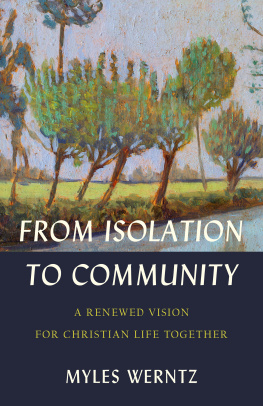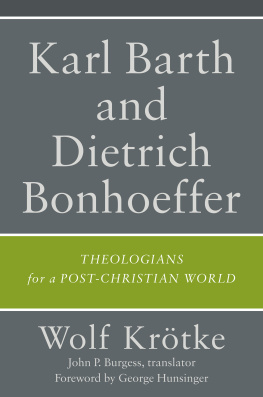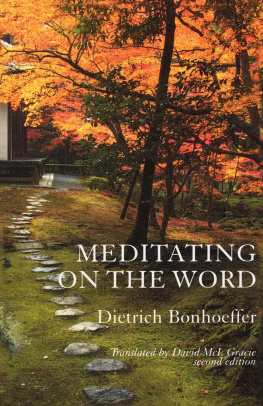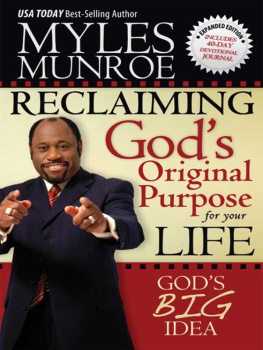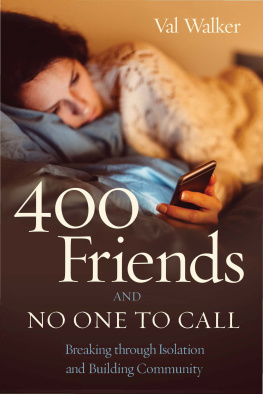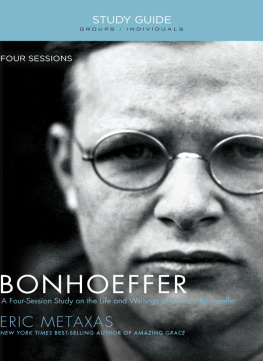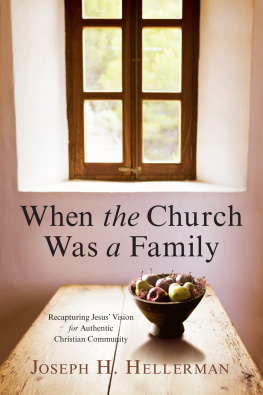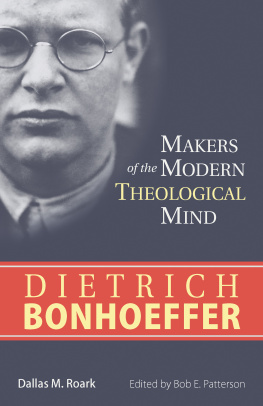Endorsements
To say From Isolation to Community is reflective is to get it just right, but its eloquence and simplicity enhance its reflectivity. To say something is reflective and eloquent about someone so profound as Bonhoeffer was in Life Together is to give us fresh eyes to read Bonhoeffers classic all over again, as if for the first time. Reading Werntzs reflections on Bonhoeffer amid isolation makes me ache for life together with my brothers and sisters in Christ.
Scot McKnight , Northern Seminary
For some time we North Americans have celebrated our freedom. It turns out that what we have gotten is loneliness, meaninglessness, and, in Werntzs language, isolation. When we come to church, we just bring our isolation with us. Whats the cure? Community, carved out by Christ among his disciples, here refracted through Dietrich Bonhoeffers luminous witness. Werntz sees clearly what ails us and the cure God has already given.
Jason Byassee , Vancouver School of Theology
Through much of the modern period, Christianity adapted itself to succor the needs of atomized individuals at the mercy of profound social change. Unwittingly, this accommodation took the state of isolation as given, and thus isolation ironically repeated itself in the solutions on offer. Whether in conservative-reactionary or liberal-progressive forms, modernized Christianity modeled identity either as the selfs assertion of sovereignty or the selfs absorption into a collectivity. But according to Werntzs welcome construction of a theological alternative inspired by the work of Dietrich Bonhoeffer, the Christian gospel is essentially about the formation of community in Christ, which interprets the state of isolation as the consequence of sinful alienation from God the Creator. Resolving this spiritual alienation, community in Christ cascades out into the world in a series of joyful exchanges on the trajectory of beloved community.
Paul R. Hinlicky , Roanoke College; Evanjelick Bohosloveck Fakulta, Univerzita Komenskho, Bratislava, Slovakia
In a moment where we are relearning what community is and could be, Werntz offers us language for what was building our walls of isolation, even prior to pandemic quarantines and a socially distant reality. From Isolation to Community is a vital book for helping us to rediscover the promise and hope of life together.
Brian Bantum , Garrett-Evangelical Theological Seminary
There is no shortage of books on the thought of Dietrich Bonhoeffer. Nor is there any shortage of books on church and ministry in our contemporary moment. But books that can put these together are few and far between. Yet here is one! From Isolation to Community does so marvelously. With dexterity and depth Werntz brings Bonhoeffer to life in a way that will help churches faithfully minister in this time. Its a valuable read.
Andrew Root , Luther Seminary; author of Churches and the Crisis of Decline
Half Title Page
Title Page
Copyright Page
2022 by Myles Werntz
Published by Baker Academic
a division of Baker Publishing Group
PO Box 6287, Grand Rapids, MI 49516-6287
www.bakeracademic.com
Ebook edition created 2022
All rights reserved. No part of this publication may be reproduced, stored in a retrieval system, or transmitted in any form or by any meansfor example, electronic, photocopy, recordingwithout the prior written permission of the publisher. The only exception is brief quotations in printed reviews.
Library of Congress Cataloging-in-Publication Data is on file at the Library of Congress, Washington, DC.
ISBN 978-1-4934-3513-5
Scripture quotations are from the New Revised Standard Version of the Bible, copyright 1989 National Council of the Churches of Christ in the United States of America. Used by permission. All rights reserved.
Baker Publishing Group publications use paper produced from sustainable forestry practices and post-consumer waste whenever possible.
Dedication
To Chip Conyers,
who told me to stay
Epigraph
[People] acquire the habit of always considering themselves as standing alone, and they are apt to imagine that their whole destiny is in their own hands.... [Democracy] throws him back forever upon himself alone, and threatens in the end to confine him entirely within the solitude of his own heart.
Alexis de Tocqueville, 1835
We are all specialized forms of survivors.... We lack what we fundamentally need and forge ahead regardless, hurriedly hiding our wounds, disguising our ineptitude, bluffing our way through our weaknesses. No oneespecially not a pastorshould lose sight of that truth.
Michel Faber, The Book of Strange New Things
As you therefore have received Christ Jesus the Lord, continue to live your lives in him, rooted and built up in him and established in the faith.
Colossians 2:67
Contents
Endorsements
Half Title Page
Title Page iv
Dedication
Epigraph
Acknowledgments
Introduction: Naming Our Problem: Isolation and the Human Condition
PART ONE ISOLATION AND THE STRUCTURE OF THE WORLD
1. Life in Isolation, Then and Now
2. The Church and the Practice of Isolation
3. The Logic of Bodily Community
PART TWO THE NEW WORLD OF CHRISTIAN COMMUNITY
4. Renewing Common Life
5. Restructuring Private Life
6. Renewing the Shape of Ministry
7. Life Together Made Visible: Confession and Communion
Conclusion: After Isolation, in Isolation
Index
Back Cover
Acknowledgments
This was a book written in reflection of and gratitude for having experienced some of what I express here, and partly in aspiration for what the church is called to be. My lifes vocation thus far has been to teach the churchs future leaders, to help shepherd seminarians into church life, and it is difficult to lead someone to see what you yourself have not. Such is the case here: the gift of Christian community is rare and good and true, and I have seen it in many forms: in college dorm rooms, on summer camp staffs, in attempts at Christian communal living and through local churches. Mistakes were made. And much joy was shared.
The number of people who, during my teaching of seminarians for the last ten years, have formed me and helped me to know and see the things described here is too many for me to name individually. The faculties of George W. Truett Theological Seminary, Palm Beach Atlantic Universitys School of Ministry, Logsdon Seminary, and Abilene Christian Universitys Graduate School of Theology have all in their own ways contributed to this book, as they have all been places of nurture, attention, and care for Christs body, the church. It is a privilege to do what I do, to spend my days among people committed to the future of Christs church while acknowledging that its future is ultimately in the hands of God.
Dietrich Bonhoeffer, the main interlocutor of this book, has been a theological companion for many years. On the way, Barry Harvey, Claire Hein, Wyatt Miles, Josh Carpenter, Chris W. Moore, Jordan Mallory, Jenny C. Howell, Michael Mawson, Christopher Dodson, and the participants of the Bonhoeffer and Society section of the American Academy of Religion have been instructive for me; the students at Logsdon Seminary who suffered through my course on Bonhoeffer as interpreter of Scripture were particularly faithful fellow readers, though all interpretive errors remain mine. Todd Cederberg, rector of St. Marys Episcopal Church in Stuart, Florida, gave me the gift of leading St. Marys in a Lenten series over Life Together , during which many of these thoughts began to form. Bob Hosack, James Korsmo, and Robert Banning at Baker Academic provided invaluable assistance in shepherding this project to completion. The saints of Calvary Baptist Church in Waco, Texas; Memorial Presbyterian Church in West Palm Beach, Florida; and First Baptist Church in Abilene, Texas, have borne witness to the difficulty and promise of Christian community. And Sarah Martin-Werntz, as always, has made our home a school of holiness, leading our family in hospitality and grace.

